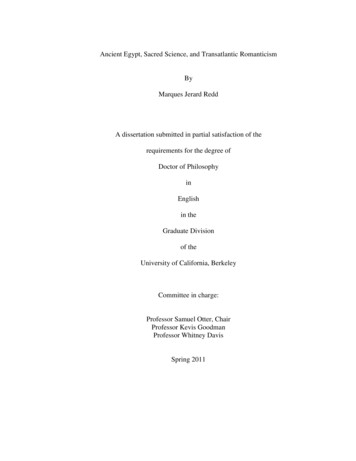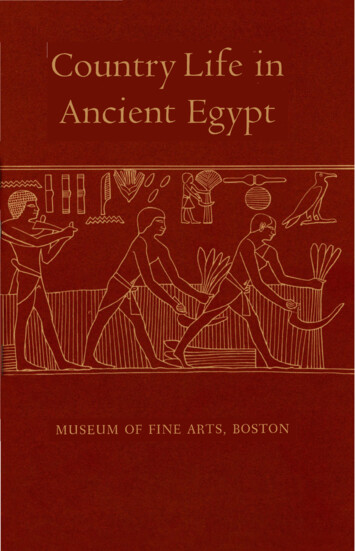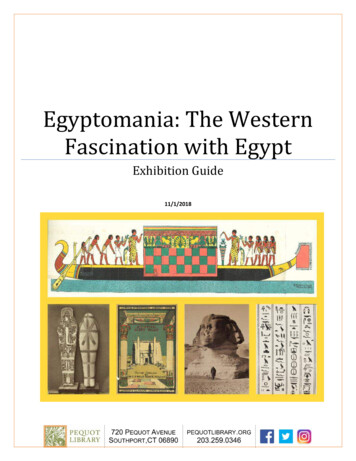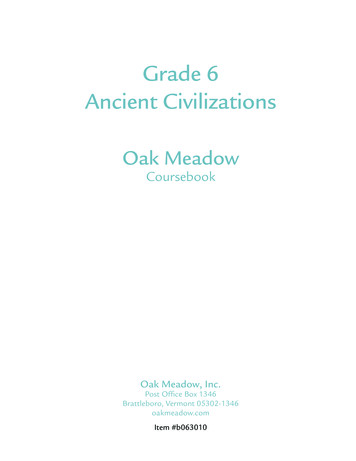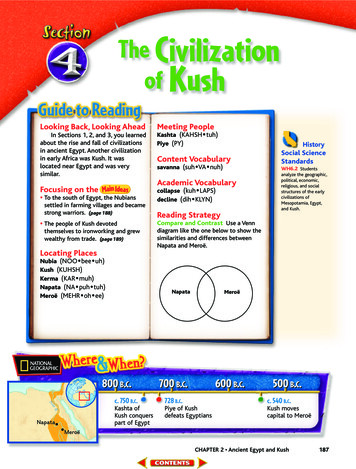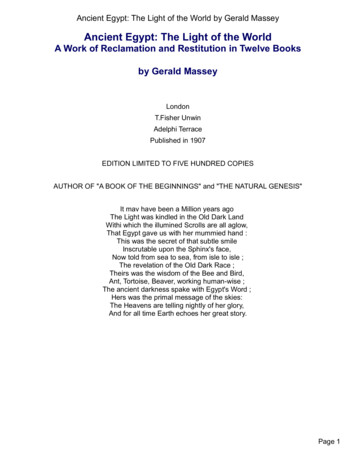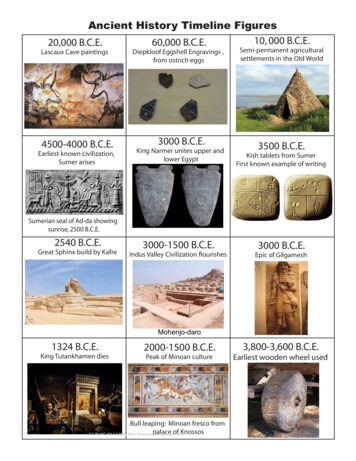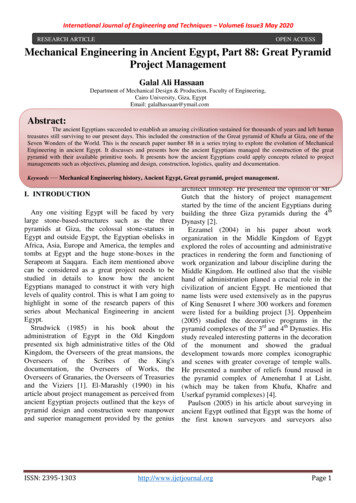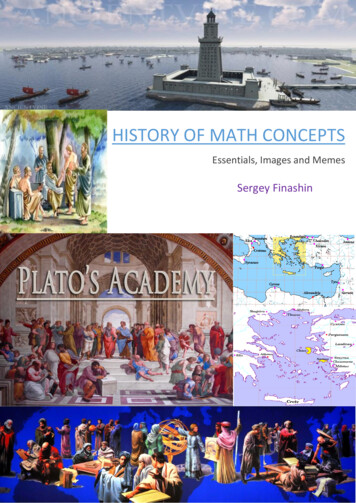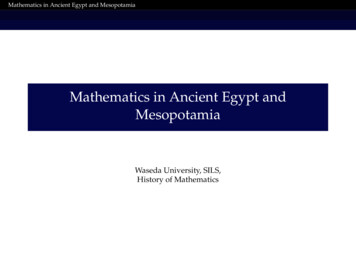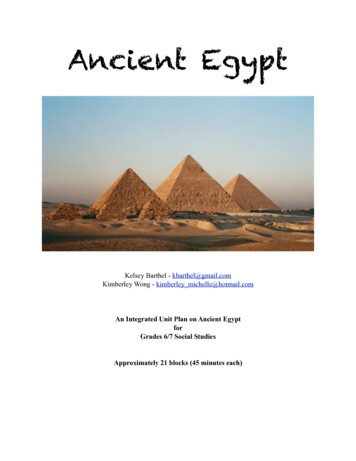
Transcription
Ancient EgyptKelsey Barthel - kbarthel@gmail.comKimberley Wong - kimberley michelle@hotmail.comAn Integrated Unit Plan on Ancient EgyptforGrades 6/7 Social StudiesApproximately 21 blocks (45 minutes each)
Class OverviewFrom Kelsey:There are 28 students in my grade 6/7 practicum class and it is split almost equally between boysand girls. This class is a social and energetic group. Their academic abilities are quite diverse. Afew of my students are ELL students, however all are fluent in English. Two students are on theautistic spectrum with an IEP and have a full time educational assistant working with them. If itis too noisy in the classroom, the EA often works with these two students outside the classroomto help them focus. A couple other students stand out as being on the lower level academically,but they do not have a specific IEP. As I pointed out, this group is quite academically diverse andwhile planning this unit I had to think about that, as well as, their high energy level.From Kimberley:My grade 6/7 class is compose of 28 students: 10 girls and 18 boys. They are a very social groupof students who are friendly with each other and work well together. There are 3 boys on IEPs.One is autistic with full time SEA support. His SEAs adapt and modify class work for him. Theother two boys are well integrated into the classroom and receive daily support from the school’sLAT. Support from the LAT is provided in the resource room or in class, depending on theweekly schedule. There is also another boy who has fixation tendencies and is being medicatedfor ADHD. He is currently undiagnosed with any learning disabilities. Aside from these 4students, the remaining 24 students fall in the traditional spectrum of high achievers to lowachievers. The class is both academically and culturally diverse.
Unit Rationale- To fulfil the IRP requirements on ancient civilizations- For students to practice their research skills using both online and text resources- For students to gain more knowledge about ancient Egypt- For students to think critically and make connections between ancient and modern civilizations- For students to practice collaborative group work- For students to gain public speaking and presentation skillsIntegrated Subject Areas:Geography- grid mapping- labelling maps- creating timelinesMath & Science- making predictions and observations- measurements and weightsArt- 2D expression in paint, pencil crayons, and/or markers- printmaking impressions- creation of a wall muralDrama- role plays- tableauLanguage Arts- perspective writing- informational writing- critical thinkingComputers- research skills
IRP ConnectionsSkills and Processes of Social StudiesA1 apply critical thinking skills – including comparing, classifying, inferring, imagining,verifying, using analogies, identifying relationships, summarizing, and drawing conclusions– to a range of problems and issuesA2 use various types of graphs, tables, timelines, and maps to obtain or communicateinformationA3 compile a body of information from a range of sourcesA4 deliver a formal presentation on a selected issue or inquiry using two or more forms ofrepresentationIdentity, Society, and CultureB2 analyze social roles within one or more ancient civilizationsGovernanceC1 describe the evolution and purpose of rules, laws, and government in ancient civilizationsEconomy and TechnologyD1 describe various ways ancient peoples exchanged goods and servicesD2 assess ways technological innovations enabled ancient peoples to- adapt to and modify their environments- satisfy their needs- develop their culturesD3 compare ancient and modern communications mediaHuman and Physical EnvironmentE1 assess how physical environments affected ancient civilizationsE2 identify the impact of human activity on physical environments in ancient civilizations
Unit Plan Overview
Unit Plan OverviewLesson(s): 1Topic: Introduction to Egypt and unitIRP Connections: A1, A3Learning Outcome:- To have students begin to inquire, explore,and discuss more about ancient EgyptActivities / Tasks:Hook:- Play 20 Questions (use Egypt or a related word such as pyramid or mummy)Activity 1: Exploring- Students look through books, noting down interesting facts on stickies- In a group (4-6 students), students will categorize their stickies into related topics/themesActivity 2: KWL worksheet- Students complete KWL worksheet with what they’ve learned and what they want to find outin this unit on EgyptClosure:- Share some things students would like to learn (possibly record on chart paper to refer backto throughout unit)- Preview of next classMaterials:- books on ancient Egypt- stickies- poster board or chart paper- pencils- felt markers- KWL worksheetAssessment:- student watch: on task, curiosity and interestlevel in topic- participation with categorizing stickies- completion of KWL worksheet
Unit Plan OverviewLesson(s): 2Topic: GeographyIRP Connections: A2, E1SWBAT:- Locate ancient Egypt on a world map- Explain the importance of the Nile in termsof settlement and development pattern- Show on a map the key physicalenvironmental characteristics of ancientEgyptActivities / Tasks:Hook:- Where is Egypt?- Without talking, have students come up and mark on an unlabeled world map where theythink Egypt isLesson:- Unveil the large wall map and hand out smaller versions of the map for students to label- Where is Egypt?- Discuss and show map- Label neighbouring countries and bodies of water- Label Upper and Lower Egypt- What river runs through Egypt? - label- Major cities:- Give pairs of students a city to pin/label on the map (Aswan, Edfu, Esna, Thebes*ancient capital*, Karnak, Memphis, Dendera, Abydos, Akhetaten, Giza, Alexandria)- Discuss the pattern of the location of cities- Why is this? What might the Nile provide for the ancient Egyptians?- Gifts of the Nile: farming, transportation, etc.- Discuss physical landscape (desert) and climate (temperature, average rainfall)?*Wall map to be referenced and used throughout unit. Additional pieces (e.g., temples,pyramids, modern day cities, etc.) will be added as each lesson area is covered.*Materials:- large wall map (blacklined by teacher)- small maps for students to label- cut outs for map (dots, pyramids, etc) tolabel map- glue- books for referenceAssessment:- labeled map (assess for accuracy)
Unit Plan OverviewLesson(s): 3-6Topic: TimelineIRP Connections: A2, A3, A4SWBAT:- Chronologically list the order of ancientEgypt’s major periods from the EarlyDynastic Period to the Ptolemaic Period- Name major events, advances, and leadersfor each periodActivities / Tasks:Day 1 & 2Hook:- Talk about yourself through a personal timelineLesson: Early Dynastic Period (0.5 class)- Model research assignment by working through the Early Dynastic Period as a classActivity 1: Research (1.5 classes)- In groups (4-6 students), students will research one of the following periods: Old Kingdom,First Intermediate Period, Middle Kingdom, Second Intermediate Period, Early NewKingdom, Late Period- Guiding questions on what to research and report on will be provided (e.g., the years spannedin each period, major events, major advances/discoveries, who was leader, wars/battles, etc.)- Students are asked to create 3-5 questions on the major points in their researchDay 3Activity 2: Presentations- Each group will deliver a 5 minute presentation on their time periodDay 4Activity 3: Review- As a class, review major events from each period and place them on a timeline (each studentwill create their timeline)Lesson:- Teach key points of the Ptolemaic PeriodAssessment:- Quiz from student created questions
Unit Plan OverviewLesson(s): 3-6Topic: TimelineMaterials:- guiding questions handout/worksheet- books to research- computers with internet- legal paper (8.5” x 14”) for timeline- timeline quizAssessment:- delivery of presentation (rubric)- accuracy of information presented- timeline- timeline quiz (class made)Lesson(s): 7-8Topic: Social HierarchyIRP Connections: B2, C1SWBAT:- Describe common social roles in ancientEgyptian times- Organize and list people of societyaccording to ancient Egyptian socialhierarchy- Explain how the social hierarchy contributedto the success of the ancient EgyptiancivilizationActivities / Tasks:Hook:- Very sincerely tell students (or have another teacher “unexpectedly” stop by to tell them) thatclass is being interrupted because Div. 1 has been asked to clean the halls with toothbrushes- Quick intro to the social hierarchy that existed in ancient Egypt and how it helped thecountry gain and maintain powerActivity 1: Role Play - An introduction to the different roles- Teacher reads out different role cards- Students will be asked to walk, action, or freeze (statue) based on the information read tothem on the character card presentedActivity 2: Role Play - Tableau- In groups of 4-6, students will create frozen scenes from ancient Egypt (e.g., the market,inside the pharaoh’s palace, building a pyramid, painting the tomb, etc.)- The teacher will provide the scene and students will add to their small group scene onestudent at a time- A different group each round will present their scene- The teacher will “animate” the chosen groups scene by tapping one or two students at a timewho will either move or speak for a few seconds in their chosen role before freezing again
Unit Plan OverviewLesson(s): 7-8Topic: Social HierarchyActivities / Tasks:Activity 3: Role play - Judgement day- As a class or half class (2 groups), students will take turns being the pharaoh and commonpeople- The teacher will provide the scene for which the commoners must plead their case before thepharaoh for judgement (e.g., a slave has attempted to escape his master, a servant refuses todo as commanded, a farmer wants to be excused from conscription to work on pyramid,someone is overheard questioning one of the pharaoh’s decisions, etc.)- Students are left to be creative in their characters by improvising their dialogue; pharaoh isencouraged to ask clarifying questions before making a rulingActivity 4: Social hierarchy reflection (to be completed after first class)- Worksheet (handout)- Students will be asked to reflect on social hierarchy as it exists in their life today (e.g.,between friends, siblings, parents, etc.)Closure:- Review of the social hierarchy and roles learned- Social Hierarchy QuizMaterials:- toothbrushes- social roles character cards- social hierarchy pyramid (poster/overhead)- social hierarchy self-reflection- social hierarchy quizAssessment:- social hierarchy self-reflection- social hierarchy quiz
Unit Plan OverviewLesson(s): 9-11Topic: Religion - Gods & TemplesIRP Connections: B2, C1SWBAT:- Name and describe common gods- Explain the role and significance of gods inancient Egypt- State the connection between gods and dailylifeActivities / Tasks:Day 1Hook:- Last night I prayed to the Money god to make me rich and when I woke up this morning(reached into pocket and pull out play money) my pockets were full of money!- Can you imagine worshipping over 2000 gods, or gods that were half animal and halfhuman?Lesson: Points to cover- Polytheism (worshipped over 2000 gods)- Appearance (use of animals)- Impact of gods on daily life and conduct- Role of the pharaoh- TemplesActivity 1: Exploration of common gods- Students will be presented with 12 common ancient Egyptian gods- Students will:- read a mini write-up (hypothetical scenario) on the presented gods- read an accompanying story- determine which of the 3 gods best fits the situation of the story- respond, in writing, which god best fits with the story and whyClosure:- Share student responses to the 4 hypothetical situations (which god they chose and why)
Unit Plan OverviewLesson(s): 9-11Topic: Religion - Gods & TemplesActivities / Tasks:Day 2Activity 2 (Review): Gods Matching game- Students will play a matching game to review gods learned in the previous classLesson: Temples- Discussion of major temples- Plot location with name on wall map (refer to Lesson #2 - Geography)Activity 3: Assignment- Students will be asked to imagine themselves as a person living in ancient Egypt- Describe themselves and their current life situation- Which god would they worship and why?- Alternatively, students may choose a god they wish to study and decide which member ofsociety is most likely to worship their chosen god- Students will be given class time to research their god- Task:- 1) a personal description of oneself and one’s current life situation as a person living inancient Egypt (paragraph style writing) and why they are worshipping a certain god- 2) a WANTED Poster of your chosen god - includes name of god, what s/he represents, aphysical description of the god, and what this god is known for (may draw from myths orlegends), where the god lives on earth; students will include a drawing of selected godDay 3Continue with Activity 3: Assignment
Unit Plan OverviewLesson(s): 9-11Topic: Religion - Gods & TemplesMaterials:- Ancient Egyptian gods handout- Gods Matching card game- Hypothetical scenarios- large paper to create WANTED poster- felts/pencil crayons- books for researching godsAssessment:- assignment (rubric) includes:- name of god- what s/he represents- physical description of god- what the god is known for (myths orlegends)- where the god lives on earth (temple)- description of your ancient Egyptian self- description of your current life situation- why you worship your chosen god(describe your beliefs in the power ofgods and how this affects your life)Lesson(s): 12-14Topic: Religion - Pyramids & MummiesIRP Connections: A1, A3SWBAT:- Explain why the Egyptians had pyramids,how they were built and explain how thisprocess might have been different today- Explain how the mummification processhelped preserve the ancient Egyptian bodiesand why that was important to themActivities / Tasks:Day 1Hook/Intro:- Show video on pyramid and mummiesActivity 1: Pyramids- Have students research the steps taken to build one of the three types of pyramids and createa flipbook, slide show, or some sort of representation of the process- How and why they were built and how could modern inventions have helped the process?- Have students create a rubric together in order to understand the guidelines
Unit Plan OverviewLesson(s): 12-14Topic: Religion - Pyramids & MummiesActivities / Tasks:Day 2Activity 2: Mummies- Students will research the mummification process and then practice the mummificationprocess on an apple in groups of four- Link (http://www.educationworld.com/a lesson/dailylp/dailylp/dailylp102.shtml)- Students will record observations before and after the mummification process and makecomparisons to mummified bodiesDay 3Activity 3: Mummies and Pyramids: What they told us about the Egyptians- Look at different pyramids, tombs, mummies and materials- Detective Work:- What type of tomb they were buried in, what type of material possessions were theyburied with, and describe the hieroglyphics inscribed on the walls around them- Have a worksheet created with different items found in the tomb and have the studentsuse knowledge from the social hierarchies lesson as well as alternate lessons to figure outwhose tomb is being describedMaterials:Assessment:- books on pyramids- pyramid flipbook- worksheets with descriptions of what was- mummification experiment observations,found in each tomb for detective workresults, and comparisons- mummification experiment materials- apples (1 for every 4 students)- plastic cups- baking soda- salt- bowl for mixing baking soda and salt- measuring cups- a scale capable of precisely weighing theapple slices before and after
Unit Plan OverviewLesson(s): 15-18Topic: Daily Life (Presentation/Gallery Walk)IRP Connections: A3, A4, (B2, D1, E2)SWBAT:- Research a specific area of ancient Egyptdrawing information from a variety ofsources- Create a presentation suitable for a gallerywalk to showcase their work and theirfindingsActivities / Tasks:Research project:- In groups of 4-5, students will research one of the topics below- Students will be asked to think about and research all social levels of society (from the richto the poor)Presentation:- Gallery walk: invite another class or a buddy class to view work and be taught about thedaily life in ancient egyptTopics:Role of Children and Education:- Research education, specifically who was educated, where, and howClothing and Jewelry:- Research the clothing and dress for men, women, and children- Create pieces of box of clothing items - which of these items would ancient egyptians wear?select your items (based on who you are in society), dress like an ancient egyptian, then take apictureFood:- Research traditional food and drink- Choose an item (e.g., beer, bread, etc.) and explain the process of how it was madeTransportation:- Research the different modes of transportation by land and by water- Build a small model of a specific mode of transportation (student choice)Games/Sports:- Research games, sports, and activities for both adults and children- Find or create a game that was or would have been played in ancient Egypt
Unit Plan OverviewLesson(s): 15-18Topic: Daily Life (Presentation/Gallery Walk)Activities / Tasks:Art:- Research the different types of art work (form, style, medium, location)Occupations:- Research different jobs, who held each job, what skills were needed?- What was the most interesting or unique job?A fun activity to do as a whole class, or Economy can be used as another area of research forthe studentsEconomy: A Day of Bartering- Give students an item of value (e.g., a chicken, a sack of flour, linen) to start with- Over the course of the day give students the opportunity to trade and barter their item(s) ofvalue for something else that they may want or need- At the end of the day, see who has what and who was most successful in gaining more itemsthrough trading- Closure: have a discussion or written reflection on why and how the monetary systemevolved from barteringMaterials:- books for researchingAssessment:- presentation (rubric created by students)
Unit Plan OverviewLesson(s): 19-20Topic: InventionsIRP Connections: D2, D3SWBAT:- Name at least 3 well known ancientEgyptian inventions and describe how theseinventions helped, adapted, or modified theenvironment to meet their needs- Compare and contrast hieroglyphics tomodern forms of writing in terms of speed,longevity, audience, and accessibilityActivities / Tasks:Day 1Hook:- Using pictures or artifacts, ask students which of these items were ancient Egyptianinventions?Activity 1: Inventions: What is it?- Students will put together 3 puzzles (made from a cut up picture) that reveals the name andpicture of an ancient Egyptian invention- Using the name and index of a book, students will locate the item and discover what theinvention was used for- Specifically answer why there was a need to create the invention in the first place, howdid it adapt or modify their environment to meet their needs- Answer if the item is still used in modern society or if the same concept positivelycontributed to the creation of a better known item in modern society- Share answers with a partner who completed 3 different puzzles- Possible inventions: pottery wheel, papyrus paper, beer, shadoof (shaduf), 365 day calendar,water clock
Unit Plan OverviewLesson(s): 19-20Topic: InventionsActivities / Tasks:Day 2Lesson / Activity 2: Hieroglyphics- A short lesson or a write up on hieroglyphics (e.g., hieroglyphics was both an ancientEgyptian invention and art form used to record and communicate; rosetta stone)- Activity (art): writing your name or a phrase in hieroglyphics- First try it with paper and paint- When the students get the hang of it have them carve into foam pieces (e.g., meat trays) when complete, use some stone coloured paint and a paint roller to allow the impressionsto pop out- Activity (writing):- after students have had a chance to experiment with hieroglyphics, provide them with anactivity sheet with questions on the speed, longevity/permanence, reach/audience, andaccessibility of such a writing and communication systemMaterials:- pictures or artifacts of ancient Egyptianinventions- 6 different puzzles (cut up pictures ofinventions)- inventions (puzzles) worksheet- write up on hieroglyphics- hieroglyphics worksheet- paint- paint brushes and paint rollers- paper- foam pieces (clean meat trays)Assessment:- inventions worksheet- hieroglyphics worksheet- hieroglyphics art activity
Unit Plan OverviewLesson(s): 21Topic: Celebration of Learning/RecapIRP Connections: All of them (in review)SWBAT:- Have fun!- Apply knowledge gained from this unit tostay in roleActivities / Tasks:Celebration of Learning: Market Life- Students will be given a social role within the middle levels of society (e.g., craftsmen,scribes) prior to the celebration; the goal is for students to conduct themselves during thecelebration in character- Students will be given “items of value” to trade and barter with and will also have theiroccupation skill to barter; the goal is for students to acquire the goods they think they willneed to live- Some “ancient Egyptian” food will be provided- Return back to the KWL sheet from Lesson #1 to see if students’ questions were answered- Have each student share 1 new fact they learned from this unit (must be different from otherstudents’ responses)Materials:- “items of value” to barter- cloth to make costumes (if students chose)- safety pins- snacks- chart paper and feltsAssessment:- N/A
Unit Plan OverviewLesson DevelopmentLesson #1 - Introduction to Ancient EgyptLesson #7 - Social Hierarchy (Day 1 of 2)Lesson #9 - Religion - Gods & Temples (Day 1 of 2)
Lesson #1 - Introduction to Ancient EgyptLesson #1 - Introduction to Ancient EgyptPrescribed Learning Outcomes:A1 – critical thinkingA3 – compile information from a range of sourcesLearning Objective:- To have students begin to inquire, explore, and discuss more about ancient EgyptMaterials Needed:- poster board- stickie notes- pens/pencils- books on Egypt- KWL worksheetHook/ Introduction (5 mins):- Play 20 Questions- Have students guess “Egypt” or another related wordLesson Body (5-10 mins):- KWL worksheets – Fill out K and W columns- Now lets see if you can answer some of the questions you want to learn more aboutIndependent/ Group Work (20 - 25 mins):- Students will take time to look through books on table to find out more about Egypt- Students will write down new or interesting information on stickie notes- As a group, students will place stickie notes into different categories/themes based oncommonality- Students will name their categoriesClosure (5 mins):- Discuss whether or not students were able to answer their “W” questions on the worksheet- Next time we will be learning about the gods of ancient Egypt
Lesson #1 - Introduction to Ancient EgyptName:Ancient EgyptKWLWhat do you know?What do you want to find out?What did you learn?
Lesson #7 - Social HierarchyLesson #7 - Social Hierarchy (Day 1 of 2)Prescribed Learning Outcomes:A1 - Apply critical thinking skills to a range of problems and issuesB2 - Analyze social roles in an ancient civilizationC1 - Describe the purpose of rules, laws, and government in an ancient civilizationStudents will be able to (SWBAT):- Describe common social roles in ancient Egyptian times- Organize and list people of society according to ancient Egyptian social hierarchy- Explain how the social hierarchy contributed to the success of the ancient Egyptian civilizationMaterials Needed:- Social Role Cards- Social Role Pyramid- Pen/Pencil- Social hierarchy self-reflection worksheetIntegration:- DramaHook / Introduction (5 mins):- What would you do if Mr. Sakai came into the room and told everyone that they had to clean upthe whole entire school with tooth brushes? Do you think that would happen?Lesson Body (10 mins):- Discuss the concept of social roles. Do we have social roles in our society today?- Introduce the social hierarchy pyramid. Discuss the different levels of societyActivity - Role Play (15 mins):- The teacher reads role play character cards one at a time- Prompts students to think, “If you were a slave or a criminal, how would you holdyourself? Do you think you would be proud, ashamed, timid/shy?”- After reviewing the different social roles, have each student pantomime a social role- Have a couple of students demonstrate and have the class guess the pantomimed social role- Have students tell you why they guessed what they did, what did they notice that toldthem which social role was being pantomimed- Set up a scene (e.g., on a farm, at the market, in the pharaoh’s palace) - Tableau- Have students freeze in the position of a social role that might be found there- Teacher may choose to “animate” the scene by tapping students, indicating to thestudent to move or speak in their character
Lesson #7 - Social HierarchyClosure (10 mins):- Ask students what was discussed and learned in class regarding ancient Egyptian social rolesand hierarchy- Give students self-reflection social hierarchy worksheet so they can make connections betweentheir life in today’s society with that of ancient EgyptMaster WorksheetsSocial Hierarchy Self-ReflectionName:What type of social hierarchydo you experience in your life?How does your experience compare to the socialhierarchies experienced in ancient Egypt?(Suggestions: you and your friends, youand your sibling(s), you and your mom ordad)
Lesson #7 - Social HierarchySocial Role Character CardsSlavesPriestYou are an Egyptian who hasfallen into debt and cannot feedyourself. To pay off your debtsyou have decided to sell yourselfinto slavery, while still ensuringyou are fed and housed. Youmay also be a slave if you werecaptured during war and are aforeign prisoner.You consider yourself a “servantof the gods.” As a male priestyou conduct ceremonies and helpwith the temple’s daily business.As a female priestess you workedas a musician and dancer.As a slave you work the hardestjobs and are paid the leastamount of money for your work.You are the least important andthe poorest member of society.You are forced to work onbuilding projects and on the landeither helping to plow the fieldsor grinding grains into flour tomake bread. Worst of all, youare bought and sold by yourowners as if you are one of theirpossessions.Spinner & WeaverAs a spinner or a weaver you arepart of a group of workers knownas craftsmen (or trade workers inmodern terms). Both men andwomen performed this job. Yourduties as a spinner is to tease afew fibers from a larger ball ofYou do not hold a permanentflax fibers and spin the fibersposition but work as part of atogether until you create a singleteam of priests on a rotatingthread. As a weaver you workschedule. You serve one month with a loom to transform the spunfollowed by 3 months of civil life. flax thread into linen cloth.You may come from an ordinaryfamily and return to your normal You represent a middle-classdaily life as a craftsman duringmember of society. You areyour 3 months off.higher than slaves and farmers,but below priests and scribes.Priesthood was usuallyStill your work is valued as youhereditary; however, anyone can make the finest linens for thebecome a priest. The onlypharaoh down to coarse cloths forqualification you require to enter ordinary peasants.priesthood is to be pure and toshow respect for the temple gods.Other craftworkers include:All of your “formal” trainingcomes from the temple’s school. jeweler, carpenter, stoneworkerArtistHigh PriestYou are usually a draftsman, apainter or a sculptor who worksdirectly for the pharaoh. Youwork as part of a team with otherartists to complete murals ontemple and tomb walls andsculptures. Since you work forthe pharaoh, he may occasionallylend you to work for privateindividuals and temples.You are in charge of performingrituals for the gods in the temples.You have to shave your head andbody to make sure you are pureenough to enter the temple. Youare the only priest allowed in thetemple’s inner sanctuary wherethe temple’s god statue isenclosed, thus you have a lot ofpower, both religious and secular.You control the wealth of thetemple’s treasury and also of theland surrounding it.Your work is highly valued andyou are a privileged member ofsociety. You are a wealthy andcompensated well for your work. Your main duties, besidesYou often receive gifts of land,overseeing the priests below you,cattle, and valuables.are to wash the temple’s godstatue, dress it in clean clothes,and nourish it with food everyday.
Lesson #7 - Social HierarchyFarmerScribeYou are a member of the largestworkforce in society and are anessential worker to Egypt and theeconomy. You are a respected andvalued member of society for youproduce the food that all peopleconsume from the Pharaoh to theslaves.You are considered Egypt’sprofessional writer. As such, youare a privileged member of societyand belong to a special class ofworkers known as Scribes. Yourjob duties vary from writingletters and contracts to recordingthe harvest and collecting theState’s taxes.Your job is to tend to your fieldsand animals. For about 4 monthsof the summer your fields areflooded by the rise of the Nile.During this time you can rest andrelax unless the State calls uponyou to help build the temples andpyramids. Some of our othertasks include maintaining thedikes, canals, and ditches that helpirrigate your fields during the dryseason.Only boys can become scribes.Beginning around age 4 or 5,scribes teach their sons thenecessary skills to read and write.By the time you are 16 years oldyou have learned your trade andare ready to begin working as aprofessional scribe. You maychose to write in hieroglyphs, orsimpler scripts of hieratic ordemotic.You are not able to read and writebecause you are not educated.You live a simple lif
Feb 13, 2019 · Language Arts - perspective writing - informational writing - critical thinking Computers - research skills. IRP Connections . - Quick intro to the social hierarchy that existed in ancient Egypt and how it helped the country gain and maintain power Activity
